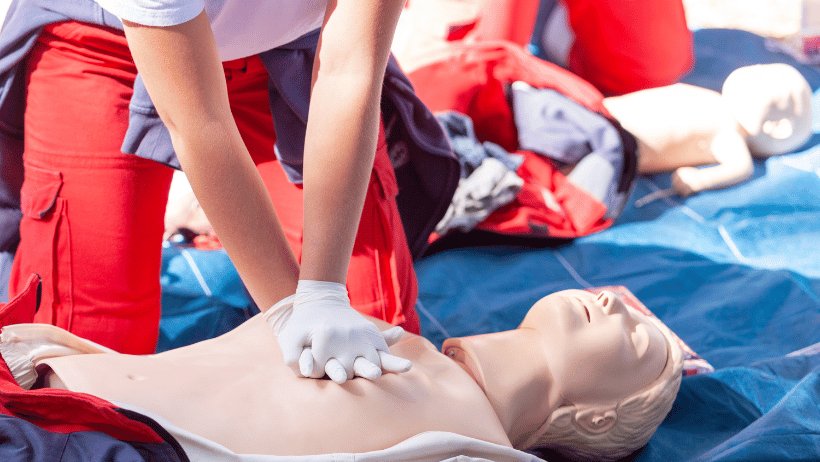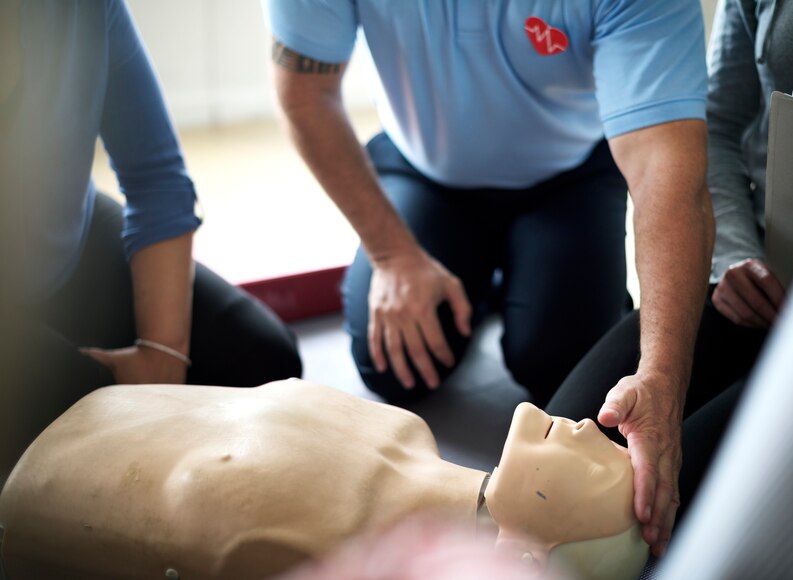Workplace CPR and first-aid training are more crucial than ever. Each year, thousands of people face medical emergencies at work, and being prepared with the right skills can save lives. This blog will guide you through the importance of these training programs, how they benefit both employees and employers, and what you can do to foster a safer workplace.
Understanding CPR and First-Aid Training
CPR, or cardiopulmonary resuscitation, is a lifesaving technique used in emergencies when someone’s heart stops beating. First-aid training involves learning how to handle various medical incidents, from cuts and burns to cardiac arrest. These skills are not only essential in personal life but are vital in professional settings where accidents can occur at any time.
Having CPR and first-aid training in the workplace equips employees with the knowledge to act swiftly and effectively during emergencies. For example, if a colleague chokes on food or faints, a trained individual can provide immediate assistance, potentially saving their life. The skills learned in these courses extend beyond the workplace, benefiting communities and families as well.
The importance of CPR and first-aid training cannot be overstated. These skills empower individuals to perform critical interventions during the crucial moments before professional medical help arrives. Immediate action can dramatically improve outcomes, reducing the risk of severe injury or death.
Why Every Workplace Needs Training
Workplace safety is a shared responsibility. By implementing CPR and first-aid training, employers demonstrate their commitment to their employees’ well-being. This training promotes a culture of safety, encouraging everyone to be vigilant and prepared for unforeseen incidents.
The presence of trained individuals can boost morale and foster a sense of security among employees. When workers feel safe, they are more focused and productive. They know that in an emergency, help is nearby, which can reduce anxiety and stress levels.
Furthermore, training your staff in CPR and first-aid can protect your company from legal liabilities. In the event of an accident, having trained personnel can show due diligence in safety measures, potentially reducing the risk of lawsuits.
Benefits for Employees
Employees who undergo CPR and first-aid training gain valuable skills that can be applied in various aspects of their lives. These are not just workplace skills; they are life skills. Knowing how to respond in a crisis can make employees feel more competent and confident.
The training fosters teamwork and collaboration. Employees learn to rely on each other, understanding that during an emergency, swift and coordinated action is necessary. This can lead to stronger bonds and a more supportive work environment.
Additionally, having first-aid training can boost career prospects. Many employers value candidates who possess these skills, seeing them as proactive and responsible individuals committed to safety and well-being.
Steps to Implementing a Training Program
To start a CPR and first-aid training program in your workplace, follow a few simple steps. First, assess the specific needs of your organization. Consider the size of your workforce and the type of work they do. This will help you determine the level and scope of training required.
Next, select a reputable training provider. Look for certified organizations like Safety Training Seminars that offer comprehensive courses tailored to workplace needs. Research options in your area, and read reviews to find a program that suits your requirements.
Schedule training sessions that accommodate your employees’ schedules. Offer flexible timing and multiple sessions to ensure everyone has an opportunity to participate. Make it convenient for your staff to attend without disrupting their regular duties.
What to Expect During Training
CPR and first-aid training involves both theoretical and practical components. Participants will learn about the human body’s basic functions and how to recognize signs of distress. They will also gain hands-on experience in performing CPR, using defibrillators, and applying first-aid techniques.
The training will include demonstrations and practice sessions. Trainees will work in groups, practicing on mannequins and role-playing various emergency scenarios. This interactive approach ensures that employees are comfortable and confident in applying their skills.
Upon completion, employees will receive certification, showcasing their competence in handling emergencies. This certification is often valid for a specified period, after which refresher courses may be required to maintain proficiency.
Building a Culture of Safety
To maximize the impact of CPR and first-aid training, integrate it into your company’s culture. Encourage ongoing learning and practice by offering regular refresher courses and updates on new techniques or guidelines.
Promote awareness of safety protocols among all staff members. Display posters and guides in common areas, and provide easy access to resources and equipment. Empower employees to take charge of their safety and the safety of their colleagues.
Recognize and reward employees who successfully complete the training. Celebrate their dedication to safety, and encourage others to follow suit. This recognition reinforces the importance of the training and motivates others to participate.
Overcoming Common Challenges
Implementing a training program may come with challenges, such as budget constraints or scheduling conflicts. To address these, consider partnering with local organizations or health departments that may offer subsidized training.
If scheduling is an issue, explore online training options. Many providers now offer virtual courses that provide flexibility while maintaining the quality of instruction. This option allows employees to learn at their own pace, fitting the training into their busy lives.
Encourage management and leadership to prioritize training. Demonstrate the value of investing in safety by highlighting the benefits, such as reduced accident rates and increased employee satisfaction.
Staying Updated with Trends
First-aid and CPR techniques are constantly evolving, with new research and technology influencing best practices. Stay informed about the latest trends by subscribing to industry publications and attending workshops or seminars.
Encourage continuous learning among your staff. Share articles and updates regularly, and invite experts to speak at your workplace. Keeping up-to-date with trends ensures your employees are always prepared to handle emergencies effectively.
Consider joining professional networks or associations focused on safety and emergency response. These communities offer valuable resources, networking opportunities, and access to the latest developments in the field.
The Role of Technology
Modern technology has revolutionized CPR and first-aid training. Automated External Defibrillators (AEDs), for instance, are now widely available and user-friendly, providing step-by-step instructions to assist in resuscitation.
Many training programs incorporate technology through virtual reality simulations, offering immersive experiences that enhance learning and retention. These tools allow participants to practice in realistic scenarios without the pressure of real-life emergencies.
Mobile apps and online platforms provide quick access to first-aid resources and guides. Encourage employees to download these apps, making it easier to reference techniques and procedures when needed.
Encouraging Employee Participation
Employee engagement is key to a successful training program. To encourage participation, emphasize the personal and professional benefits of CPR and first-aid training. Highlight stories of lives saved and injuries prevented through quick action.
Create an inclusive environment where all employees feel welcomed and motivated to join the training. Address any concerns or fears they may have about the training process, and reassure them of the importance of their contribution to workplace safety.
Consider offering incentives for participation, such as certificates of achievement, recognition at company meetings, or small rewards. These incentives can motivate employees to take part and complete the training.
Conclusion
The importance of workplace CPR and first-aid training cannot be overstated. By equipping employees with these vital skills, organizations can foster a safer, more prepared work environment. Training can save lives, reduce injuries, and boost morale, creating a positive atmosphere that benefits everyone.
Take the first step today by implementing a training program in your workplace. Explore options that suit your needs, and encourage your staff to participate actively. Together, you can build a culture of safety that empowers employees to act confidently and efficiently in emergencies.
For additional resources and information on CPR and first-aid training, contact us today. Join the movement to create safer workplaces and communities everywhere.






